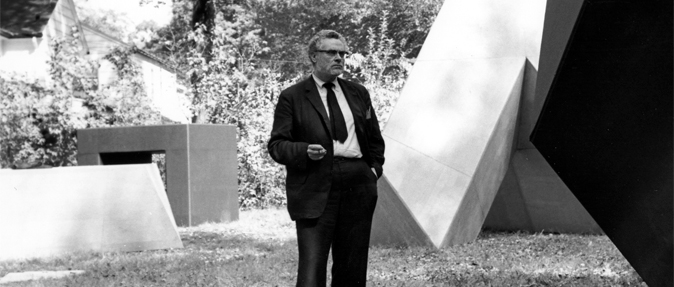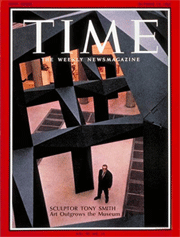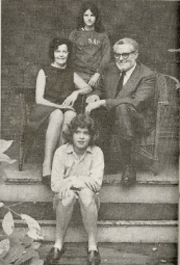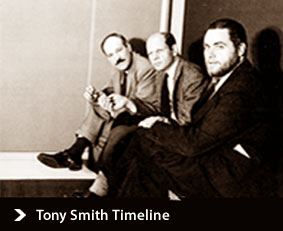
Tony Smith in his South Orange backyard with sculpture maquettes
About Tony Smith
Tony Smith was one of the most influential artists of the 20th century. A sculptor, painter, and architect who apprenticed with Frank Lloyd Wright, he reached international fame in the 1960s and 1970s with his large-scale, geometric sculpture.
Anthony Peter Smith was born on September 23, 1912, in South Orange, New Jersey. His grandfather and namesake A.P. Smith founded a municipal waterworks factory in nearby East Orange. The young Smith would visit the factory often, fascinated by the machinery and the fabrication process. In his early twenties, while helping with the family business, Smith attended the Art Students League of New York, studying painting, drawing, and anatomy.
In 1932, Smith visited the International Style architecture exhibition at the Museum of Modern Art and was deeply impressed by it. A few years later, he moved to Chicago to work in the offices of Frank Lloyd Wright before striking out on his own as an architectural designer. Though he received several prominent commissions, Smith disillusioned with the business and returned to New York to focus on his art.
During the 1940s and 1950s, Smith continued to paint, befriending the Abstract Expressionist artists Barnett Newmann, Jackson Pollock, Mark Rothko, and Clyfford Still. He also began to experiment with simple, three-dimensional geometric shapes, combining and then enlarging them to create drama through scale. While the mock-ups were often made of cardboard or wood, the final work was envisioned in steel.
Smith exhibited this new form of sculpture for the first time in 1964; in 1967 he made the cover of TIME Magazine as “Master of the Monumentalists.” He had become an international sensation. A major retrospective at the Museum of Modern Art, New York, in 1998 introduced Smith’s daring work to a new generation of viewers.
Tony Smith created many of his famous sculptures in his original childhood home in South Orange, where he lived with his wife Jane and their daughters Kiki, Seton, and Beatrice. Often he created plywood mock-ups of these works in his backyard. Smith’s artist friends, who included Newman, Pollock, and Rothko, along with the playwright Tennessee Williams, visited him there regularly. His children attended the town’s public schools.
Smith died of a heart attack in 1980, at the age of 68.
Throughout his career, Smith taught at various colleges and universities, including New York University, Cooper Union, Pratt Institute, Bennington College and Hunter College.
Today, examples of Smith’s work can be found at MoMA in New York, the Metropolitan Museum of Art, The Whitney Museum of American Art, the Guggenheim Museum, The National Gallery of Art, The Hirshhorn, the Walker Art Center, The New Jersey State Museum, the Newark Museum, the Montclair Art Museum, and the Nasher Sculpture Center. Cities where Smith’s work has been on public display include New York, Detroit, Princeton, Seattle, Minneapolis, San Antonio, Cambridge, Ottawa, Buffalo, Seoul, Dallas, Tokyo, Valencia, Boston, St. Louis, Louisville, Philadelphia, Cleveland, Pittsburgh, New Orleans, Toledo, Houston, Rochester, Washington, D.C., Baltimore, Oslo, Honolulu, Albany, Milwaukee, San Francisco, and Miami.
The Matthew Marks Gallery in New York City represents the Tony Smith estate. For more information, visit the gallery website.

1967 TIME magazine cover: Master of the Monumentalists

Tony and Jane with daughters




